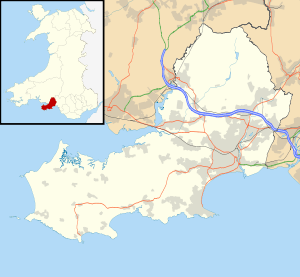Llangennith
Coordinates: 51°36′04″N 4°16′23″W / 51.601°N 4.273°W
Llangennith (Welsh: Llangenydd/Llangynydd) is a village in Gower, in the City and County of Swansea, south Wales. It sits at a crossroads in northwest Gower: Moor Lane leads westwards to a caravan park near Rhossili Bay; while Burrows Lane leads northwards to a caravan park overlooking Broughton Bay. The village has a scattering of houses, centred on St Cenydd's church, and one pub - the King's Head. The neighbouring bay is popular with surfers.
History
The village of Llangennith clusters round a central village green and the church of St Cenydd (also Kyned/Cynydd) - the largest in Gower - which was founded in the 6th century, in the days of the undivided Church. According to legend the church was established as a hermitage by St Cenydd; but in 986 the early buildings were destroyed by Vikings. The present structure dates from the 12th century - it was consecrated in 1102 - when Norman war-lords were building castles and churches all over Gower, as elsewhere in Britain. The large fortified square tower is unusually placed north of the nave and features remnants of a significant Norman arch in its east wall, possibly associated with a small priory which was attached to the church through the Middle Ages. The church is the reputed burial place of Iestyn ap Gwrgant, the last ruler of the Welsh kingdom of Morgannwg, who is said to have become a religious at Llangennith after being deposed by the Norman Robert Fitzhamon in 1090. The church contains the mutilated effigy of a 13th-century knight known locally as 'the Dolly Mare' and believed to represent a member of the de la Mere family who held lands nearby, and a significant Norman font. The church interior was restored and remodelled in the 1880s, and the interior floor raised by several feet to counteract damp. The remodelling was relatively restrained and the church retains many original features.
A recently rediscovered mediaeval niche in the chancel arch displays a significant carved slab of around the 9th century, featuring intricate Celtic knots. This is legendarily the former grave stone of St Cenydd and, until the nineteenth century remodelling, was set flat in the chancel floor.
On the village green oppostite the church gates is the mouth of a natural spring, St Cenydd's Well, on the upper capstone of which are faint traces of a cross cut into the stone.
A short stroll south of the church is the ruined medieval village of Coety Green.
Llangennith was at one time the most infamous, rough-and-ready village on the peninsula, its villagers referred to in Gower dialect as 'Llangenny Oxen', always the first to rush to any shipwreck, particularly those in Rhossili Bay, and feuding with neighbouring villagers over any plunder they could find.
During World War One, when the British government introduced daylight saving, the villagers held a public meeting - and graciously voted to fall in line with the rest of the country, for a trial period of one month.
In the churchyard are buried the Gower folk-singer, Phil Tanner, who died in 1950; and Anthony Eyre DFC (1918–1946) [1]
Physical features
The beach is now mainly a centre for surfers, and is located at the north end of Rhossili Bay; the bay stretches for over three miles. Llangennith is a popular surfing location mainly because of the consistent swells that pour in from the Atlantic Ocean. There are several surfing schools providing lessons during the summer.
The beach is backed by sand dunes, and at the north end is the island of Burry Holms. There are gentle walks north-west to the coast over the sand dunes of Llangennith and Broughton Burrows. Sights to watch out for include Blue Pool, a rock pool which, in the right sea and sky conditions, takes a deep blue colour; the natural archway called Three Chimneys; and Culver Hole, a bone cave.
Notable residents
- Cenydd - saint
- Tracy Edwards - yachtswoman
- Ryan Jones - Wales Rugby International
- Phil Tanner (1862–1950) 'The Gower Nightingale', folk singer [2]
- Euros Lyn - Television director
External links
- St. Cenydd's Church, Llangennith
- Llangennith, Llanmadoc and Cheriton Community Council
- Llangennith, Llanmadoc and Cheriton community/parish magazine- village, community and regional information, current affairs and history
References
- ↑ "Anthony Eyre DFC". Retrieved 2011-08-14.
- ↑ "Phil Tanner, 1862-1950". Retrieved 2012-05-17.
